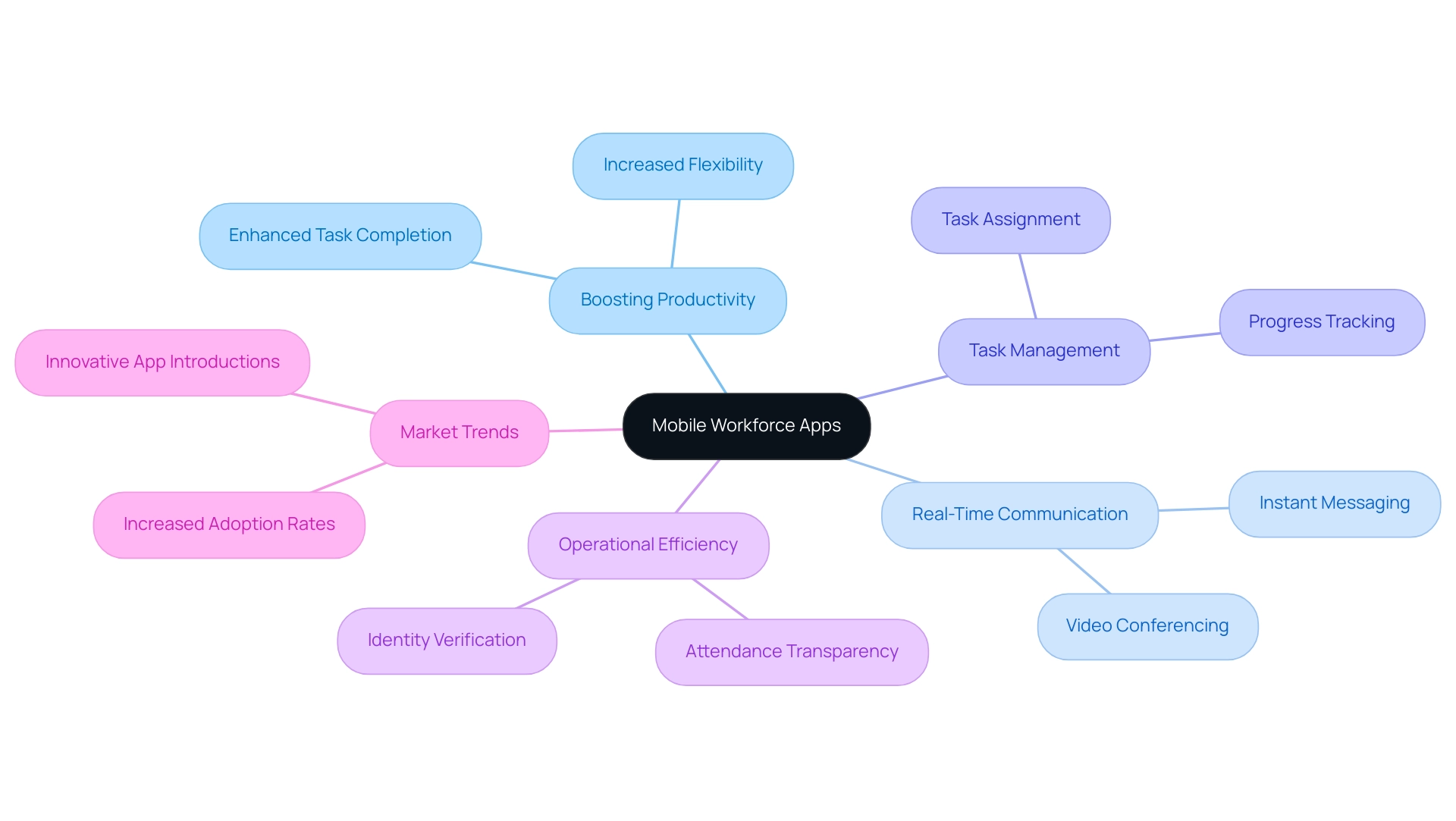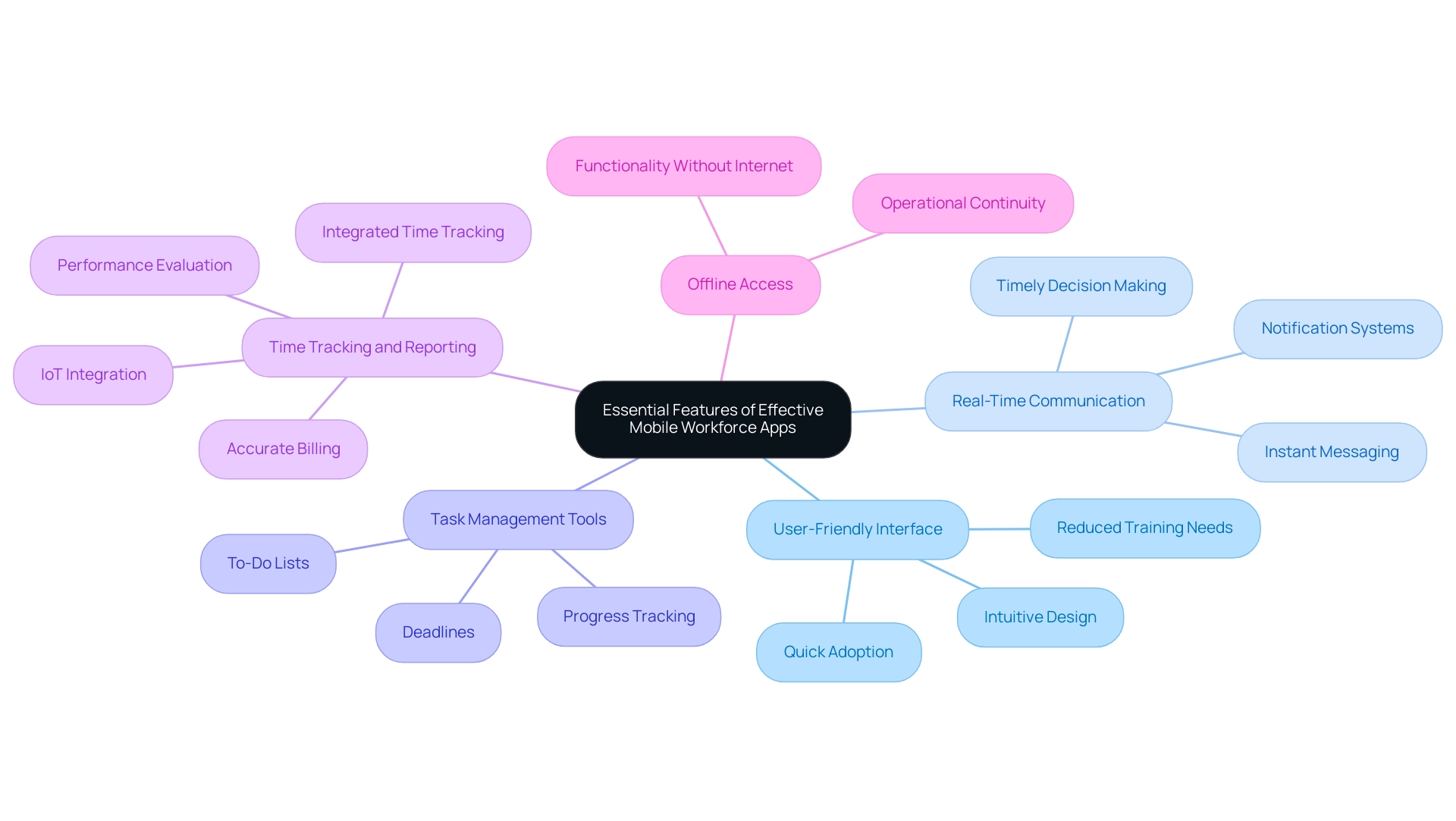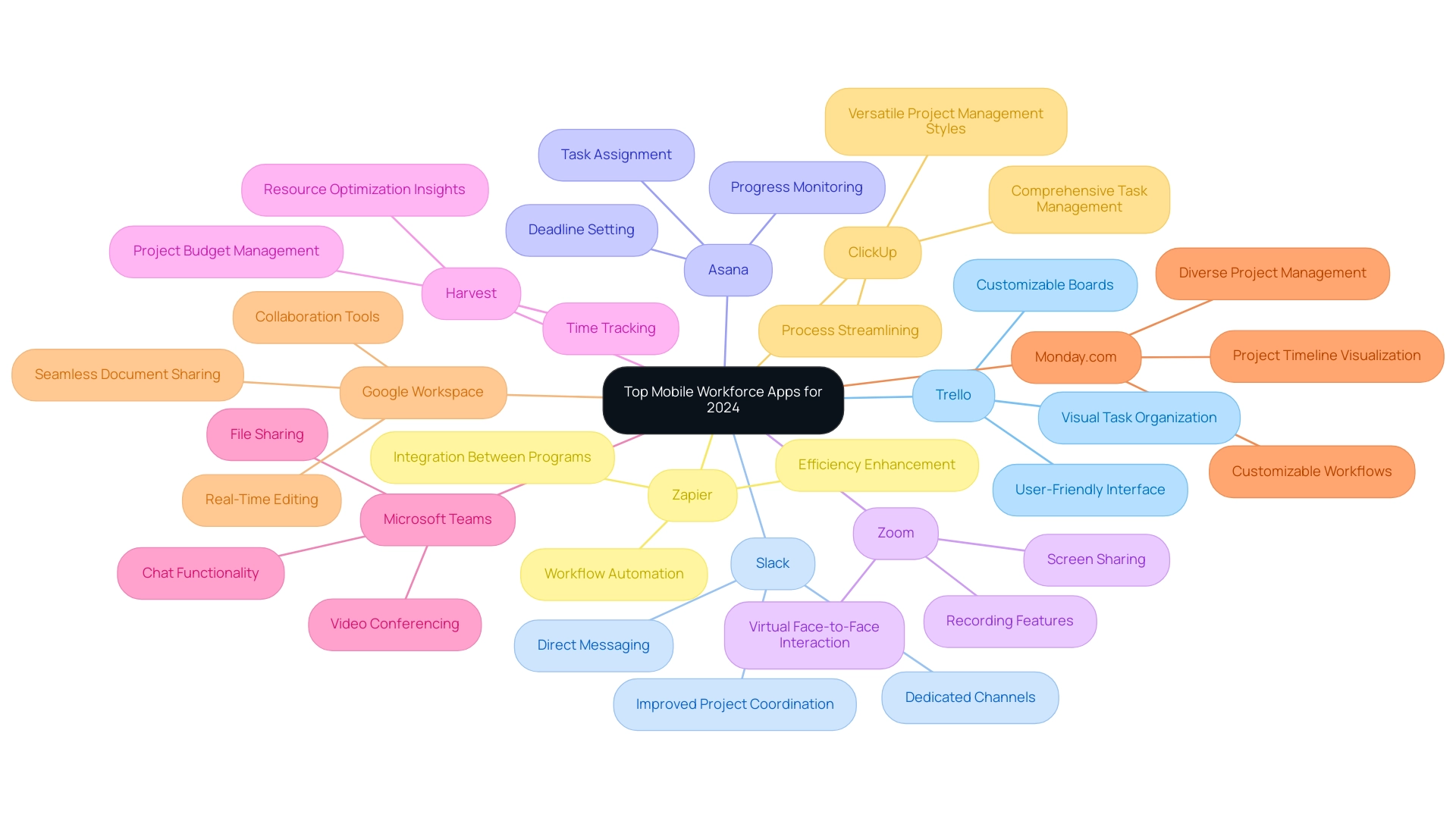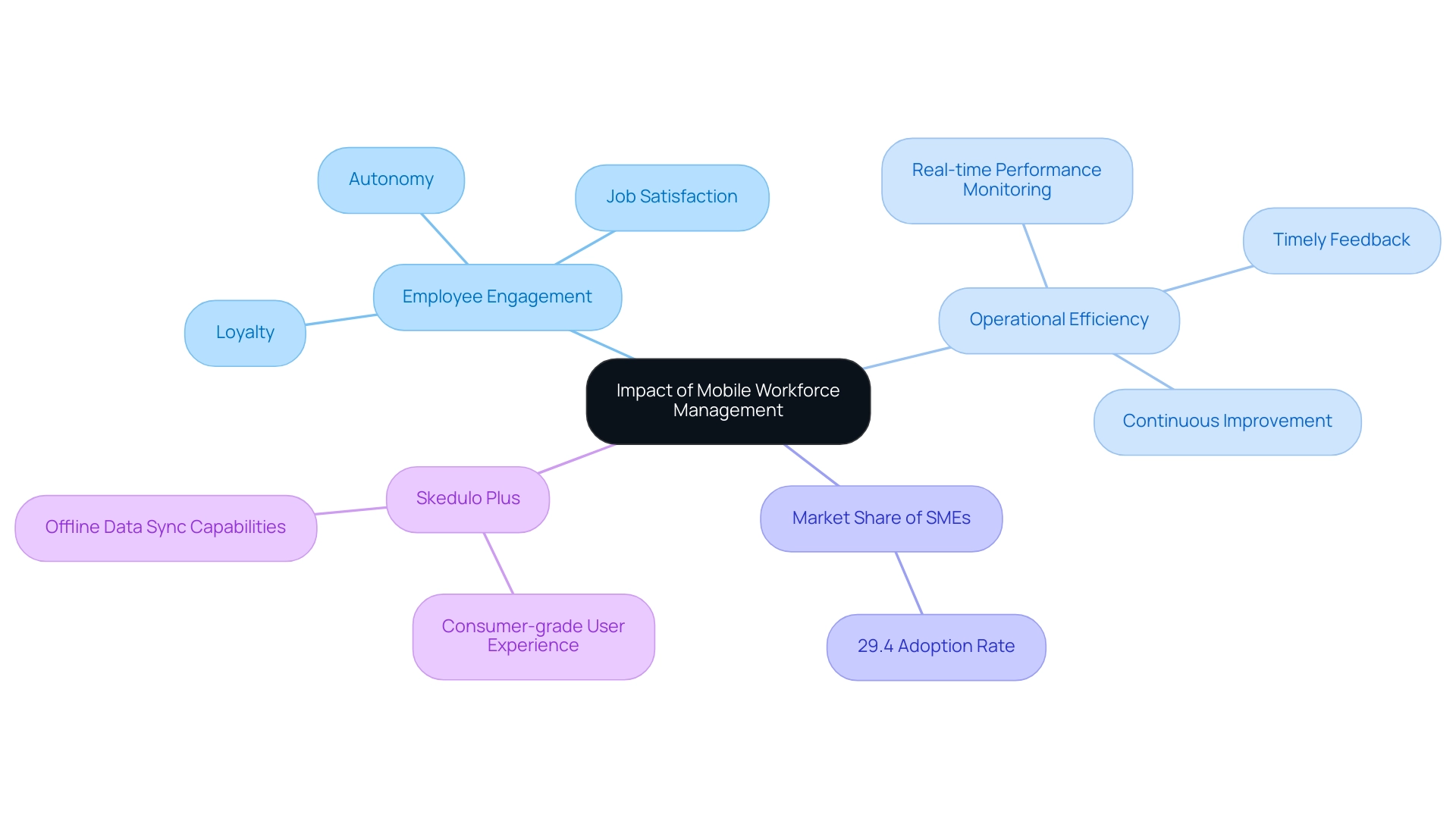Introduction
In an age where flexibility and efficiency are paramount, mobile workforce applications have emerged as vital tools for organizations striving to elevate productivity and streamline operations. These innovative solutions empower employees to access critical information and complete tasks from virtually anywhere, effectively dismantling the barriers of traditional office settings.
With features that promote real-time communication, task management, and seamless data access, these apps not only enhance collaboration but also address the challenges posed by conventional attendance systems in remote work environments.
As businesses increasingly recognize the transformative potential of mobile technology, understanding the essential features and top applications available in 2024 becomes crucial for harnessing their full benefits.
This exploration delves into the key components of effective mobile workforce apps and highlights the leading tools that can propel teams toward greater success.
Understanding Mobile Workforce Apps: A Key to Enhanced Productivity
Mobile workforce apps have become essential for businesses aiming to boost productivity and optimize operations. These innovative apps allow employees to access essential information and complete tasks from anywhere, effectively transcending the limitations of traditional office environments. By enabling real-time communication, task management, and seamless data access, applications for remote teams empower groups to collaborate efficiently, regardless of their physical location.
This capability addresses critical concerns, as traditional attendance systems often struggle with accurate tracking in remote settings, leading to challenges in identity verification and attendance transparency. The adoption of portable technology not only enhances operational efficiency but also cultivates a culture of flexibility and responsiveness—qualities that are increasingly vital in today’s rapidly evolving business landscape. Major trends in the Mobile Workforce Management market highlight the introduction of innovative mobile workforce apps that further enhance productivity.
According to forecasts for 2024, the adoption rate of mobile workforce apps for remote workers is expected to increase substantially, indicating the growing acknowledgment of the advantages these tools provide. For instance, a case study titled 'Resolving Conflict Over New Analysis Methods' demonstrates how portable team tools can effectively address challenges within groups, fostering collaboration and reducing friction. To examine these uses, companies can utilize a 7-day complimentary FULL FEATURE trial of Workstatus, allowing them to witness firsthand the transformative effect of mobile workforce apps on their operations.

Essential Features of Effective Mobile Workforce Apps
When evaluating mobile workforce apps, it is crucial to prioritize features that can significantly enhance productivity and streamline operations. Here are the most important attributes to consider in 2024:
-
User-Friendly Interface: An intuitive design is paramount.
A simple layout allows employees to navigate the app effortlessly, reducing the need for extensive training and fostering quicker adoption. Considering that users invest significant time in social networking applications, highlighting user-friendly design is crucial in the ecosystem. -
Real-Time Communication: Effective mobile apps must include instant messaging and notification systems.
This connectivity enables group members to share updates and make timely decisions, which is essential for maintaining workflow efficiency. -
Task Management Tools: Strong task management features—such as to-do lists, deadlines, and progress tracking—are essential for keeping groups organized and accountable.
These features help ensure that projects stay on track and that responsibilities are clearly defined. -
Time Tracking and Reporting: Integrated time tracking is critical for accurate billing and performance evaluation.
This functionality not only aids in productivity assessments but also supports transparent reporting, which is increasingly important as traditional attendance systems face challenges in remote environments. IoT-supported smart shelves, for instance, can automatically record inventory levels, showcasing how technology can enhance operational efficiency. -
Offline Access: The capability to function without an internet connection is a game-changer for portable application users.
This feature guarantees that employees can carry on with their tasks without interruption, even in regions with unstable connectivity, thus preserving operational continuity.
By focusing on these characteristics, organizations can choose mobile workforce apps that truly enhance productivity while meeting the changing requirements of their teams. As Shivani Singh, a Content Specialist, observes, 'A user-friendly interface is not just a feature; it's a necessity for contemporary software.'
This approach aligns well with the increasing reliance on portable technology in the workplace, as evidenced by the substantial time users dedicate to social networking apps, underscoring the importance of user-friendly design in the portable ecosystem.

Top Mobile Workforce Apps to Consider for Your Team
Here are some of the top mobile workforce applications poised to significantly enhance your group's productivity in 2024:
-
Trello: Renowned for its visual task organization, Trello simplifies project management by enabling groups to easily track progress and priorities through customizable boards. Its user-friendly interface promotes engagement, making it a favorite among groups looking to streamline their workflow. However, as the quote goes, 'No app is perfect,' and users should be aware of potential limitations in functionality.
-
Slack: As a prominent communication platform, Slack integrates effortlessly with various applications and improves collaboration through dedicated channels and direct messaging. Users frequently cite improved project coordination and faster decision-making as key benefits of this tool.
-
Asana: With its comprehensive task and project management features, Asana empowers groups to assign tasks, set deadlines, and monitor progress efficiently. This capability fosters accountability and assists groups in remaining aligned on their objectives, making it a cornerstone for productivity.
-
Zoom: Essential for remote meetings, Zoom revolutionizes virtual collaboration with features like screen sharing and recording. The platform's ability to facilitate face-to-face interactions enhances group engagement, even when members are geographically dispersed.
-
Harvest: This time-tracking application is pivotal for monitoring hours worked and managing project budgets. By providing insights into time allocation, Harvest enables groups to optimize their resources effectively, leading to better project outcomes.
-
Microsoft Teams: Offering a robust collaboration platform, Microsoft Teams combines chat, video conferencing, and file sharing, creating an all-in-one solution for remote groups. Its integration with Office 365 enhances productivity, allowing for real-time collaboration on documents.
-
Monday.com: A flexible work operating system, Monday.com enables groups to customize workflows and visualize project timelines. This adaptability is essential for managing diverse projects and ensuring that all group members are on the same page.
-
Google Workspace: Providing a suite of productivity tools that includes Docs, Sheets, and Drive, Google Workspace enhances collaboration and document management. Teams benefit from real-time editing and seamless sharing capabilities, which facilitate better communication.
-
ClickUp: This comprehensive task management tool consolidates various features into one platform, enabling groups to streamline their processes and enhance productivity. Its versatility caters to a wide range of project management styles.
-
Zapier: Although not a labor tool in the conventional sense, Zapier automates workflows between programs, saving time and lessening the load of repetitive tasks. This automation is invaluable for teams seeking to enhance efficiency across multiple tools.
The implementation of mobile workforce apps not only boosts productivity but also fosters improved communication and collaboration within teams. As the remote team continues to evolve, utilizing these tools can result in substantial improvements in operational efficiency. Significantly, with paid apps anticipated to yield under $7 billion from app purchases by 2026, investing in mobile workforce apps is essential.
Furthermore, as emphasized in the case study 'Solutions for HR Leaders,' these tools can tackle urgent challenges encountered by HR leaders in overseeing employee wellbeing and stress, ultimately resulting in more effective support for teams.

The Impact of Mobile Workforce Management on Employee Engagement and Efficiency
Mobile personnel management is crucial in driving employee engagement and optimizing operational efficiency. By providing employees with mobile workforce apps that are designed for remote task execution, organizations foster an environment of autonomy and trust—key elements that significantly enhance job satisfaction and loyalty. Recent insights within the industry indicate that small and medium-sized enterprises (SMEs), which constitute 29.4% of the market share, are increasingly adopting these technologies to enhance team dynamics.
A notable example is the launch of Skedulo Plus in October 2023, which is one of the mobile workforce apps designed to enhance the management and scheduling of workers, featuring a consumer-grade user experience and offline data sync capabilities. Moreover, smartphone applications provide managers with the ability to monitor performance metrics in real-time, facilitating timely feedback and recognition of individual contributions. This level of transparency not only uplifts morale but also instills a culture of continuous improvement within teams.
As employees become more engaged and motivated, the overall efficiency of operations escalates, producing superior outcomes for the organization. As Tajammul Pangarkar, CMO at Prudour Pvt Ltd, suggests, fostering a supportive work environment is essential for enhancing employee engagement. In essence, embracing mobile workforce apps transcends mere productivity enhancement; they foster a work environment that genuinely values employee contributions and actively promotes growth.

Conclusion
Mobile workforce applications are revolutionizing the way organizations operate, providing critical tools that drive productivity and enhance collaboration. By enabling remote access to essential information and facilitating real-time communication, these applications dismantle the barriers posed by traditional office environments. The ability to manage tasks effectively and track time accurately further empowers teams, ensuring projects remain on track and responsibilities are clearly understood.
The key features of effective mobile workforce apps—such as user-friendly interfaces, offline access, and robust task management tools—are crucial for fostering a productive work environment. Organizations that prioritize these attributes will not only streamline operations but also create a culture of flexibility and responsiveness, essential in today’s fast-paced business landscape.
As highlighted, the adoption of leading mobile workforce applications like Trello, Slack, and Asana can significantly enhance team productivity in 2024. These tools not only improve communication and collaboration but also address the challenges faced by remote teams, ensuring that all members are aligned and engaged. The investment in such technologies promises not just immediate benefits but also long-term gains in operational efficiency and employee satisfaction.
Ultimately, embracing mobile workforce management is not merely about adopting new tools; it is about fostering an environment that values autonomy, trust, and continuous improvement. As organizations navigate the evolving landscape of work, leveraging these applications will be pivotal in achieving sustained success and enhancing overall employee engagement. The future of work is mobile, and those who adapt will undoubtedly thrive.





